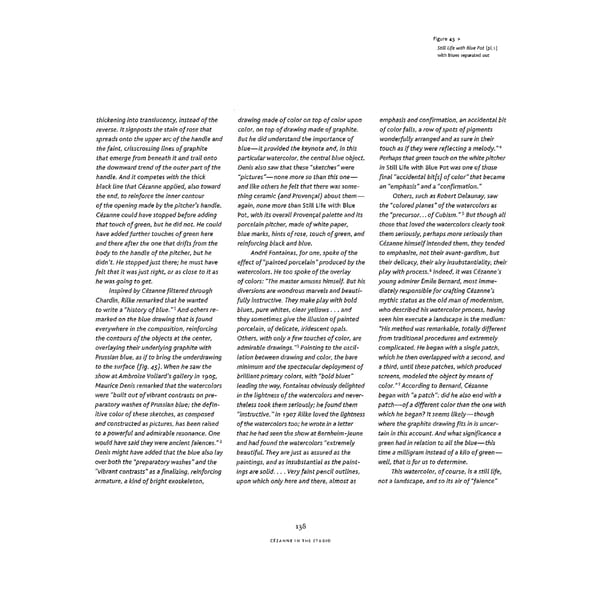Figure 45 > St/7/ Life with Blue Pot (pl.i) with blues separated out thickening into translucency, instead of the drawing made of color on top of color upon emphasis and confirmation, an accidental bit reverse. It signposts the stain of rose that color, on top of drawing made of graphite. of color falls, a row of spots of pigments spreads onto the upper arc of the handle and But he did understand the importance of wonderfully arranged and as sure in their 4 the faint, crisscrossing lines of graphite blue—it provided the keynote and, in this touch as if they were reflecting a melody." that emerge from beneath it and trail onto particular watercolor, the central blue object. Perhaps that green touch on the white pitcher the downward trend of the outer part of the Denis also saw that these "sketches" were in Still Life with Blue Pot was one of those handle. And it competes with the thick "pictures"—none more so than this one— final "accidental bit[s] of color" that became black line that Cezanne applied, also toward and like others he felt that there was some- an "emphasis" and a "confirmation." the end, to reinforce the inner contour thing ceramic (and Provencal) about them— Others, such as Robert Delaunay, saw of the opening made by the pitcher's handle. again, none more than Still Life with Blue the "colored planes" of the watercolors as 5 Cezanne could have stopped before adding Pot, with its overall Provencal palette and its the "precursor... of Cubism." But though all that touch of green, but he did not. He could porcelain pitcher, made of white paper, those that loved the watercolors clearly took have added further touches of green here blue marks, hints of rose, touch of green, and them seriously, perhaps more seriously than and there after the one that drifts from the reinforcing black and blue. Cezanne himself intended them, they tended body to the handle of the pitcher, but he Andre Fontainas, for one, spoke of the to emphasize, not their avant-gardism, but didn't. He stopped just there; he must have effect of "paintedporcelain"produced by the their delicacy, their airy insubstantiality, their 6 felt that it was just right, or as close to it as watercolors. He too spoke of the overlay play with process. Indeed, it was Cezanne's he was going to get. of colors: "The master amuses himself. But his young admirer Emile Bernard, most imme- Inspired by Cezanne filtered through diversions are wondrous marvels and beauti- diately responsible for crafting Cezanne's Chard in, Rilke remarked that he wanted fully instructive. They make play with bold mythic status as the old man of modernism, l who described his watercolor process, having to write a "history of blue. " And others re- blues, pure whites, clear yellows ... and marked on the blue drawing that is found they sometimes give the illusion of painted seen him execute a landscape in the medium: everywhere in the composition, reinforcing porcelain, of delicate, iridescent opals. "His method was remarkable, totally different the contours of the objects at the center, Others, with only a few touches of color, are from traditional procedures and extremely 3 overlaying their underlying graphite with admirable drawings. " Pointing to the oscil- complicated. He began with a single patch, Prussian blue, as if to bring the underdrawing lation between drawing and color, the bare which he then overlapped with a second, and to the surface (fig. 45). When he saw the minimum and the spectacular deployment of a third, until these patches, which produced show atAmbroise Vollard's gallery in 1905, brilliant primary colors, with "bold blues" screens, modeled the object by means of Maurice Denis remarked that the watercolors leading the way, Fontainas obviously delighted color."7According to Bernard, Cezanne were "built out of vibrant contrasts on pre- in the lightness of the watercolors and never- began with "a patch": did he also end with a paratory washes of Prussian blue; the defin- theless took them seriously; he found them patch—of a different color than the one with itive color of these sketches, as composed "instructive." In 7907 Rilke loved the lightness which he began? It seems likely—though and constructed as pictures, has been raised of the watercolors too; he wrote in a letter where the graphite drawing fits in is uncer- to a powerful and admirable resonance. One that he had seen the show at Bernheim-Jeune tain in this account. And what significance a 2 would have said they were ancient faiences." and had found the watercolors "extremely green had in relation to all the blue—this Denis might have added that the blue also lay beautiful. They are just as assured as the time a milligram instead of a kilo of green— over both the "preparatory washes" and the paintings, and as insubstantial as the paint- well, that is for us to determine. "vibrant contrasts" as a finalizing, reinforcing ings are solid.... Very faint pencil outlines, This watercolor, of course, is a still life, armature, a kind of bright exoskeleton, upon which only here and there, almost as not a landscape, and so its air of "faience" i 8 3 CEZANNE IN THE STUDIO
 Cézanne in the Studio: Still Life in Watercolors Page 152 Page 154
Cézanne in the Studio: Still Life in Watercolors Page 152 Page 154